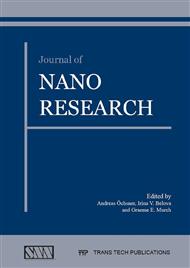[1]
C.W.S. To, Bending and shear moduli of single-walled carbon nanotubes, Finite Elem. Anal. Des. 42 (2006) 404-413.
DOI: 10.1016/j.finel.2005.08.004
Google Scholar
[2]
K. Hashemnia, M. Farid, R. Vatankhah, Vibrational analysis of carbon nanotubes and graphene sheets using molecular structural mechanics approach. Comp. Mater. Sci. 47 (2009) 79–85.
DOI: 10.1016/j.commatsci.2009.06.016
Google Scholar
[3]
S. Filiz and M. Aydugdu, Axial vibration of carbon nanotube hetero-junctions using nonlocal elasticity. Comp. Mater. Sci. 49 (2010) 619–627.
DOI: 10.1016/j.commatsci.2010.06.003
Google Scholar
[4]
S. Arghavan and A.V. Singh, On the vibrations of single-walled carbon nanotubes. J. Sound Vib. 330 (2011) 3102–3122.
DOI: 10.1016/j.jsv.2011.01.032
Google Scholar
[5]
M.M. Seyyed Fakhrabadi, A. Amini, A. Rastgoo, Vibrational properties of two and three junctioned carbon nanotubes. Comp. Mater. Sci. 65 (2012) 411–425.
DOI: 10.1016/j.commatsci.2012.08.002
Google Scholar
[6]
Z. Yao, H.W.C. Postma, L. Balents, C. Dekker, Carbon nanotube intramolecular junctions. Nature 402 (1999) 273-276.
DOI: 10.1038/46241
Google Scholar
[7]
S. Imani Yengejeh, M. Akbar Zadeh, A. Öchsner, Numerical modeling of eigenmodes and eigenfrequencies of hetero-junction carbon nanotubes with pentagon–heptagon pair defects. Comp. Mater. Sci. 92 (2014) 76–83.
DOI: 10.1016/j.commatsci.2014.05.015
Google Scholar
[8]
S. Imani Yengejeh, J.M.P.Q. Delgado, A.G.B. de Lima, A. Öchsner, Numerical Simulation of the Vibration Behavior of Curved Carbon Nanotubes. Advances Mater Sci Eng. http: /dx. doi. org/10. 1155/2014/815340.
DOI: 10.1155/2014/815340
Google Scholar
[9]
A. Ghavamian and A. Öchsner. Numerical modeling of eigenmodes and eigenfrequencies of single-and multi-walled carbon nanotubes under the influence of atomic defects. Comp. Mater. Sci. 72 (2013) 42-48.
DOI: 10.1016/j.commatsci.2013.02.002
Google Scholar
[10]
S. Imani Yengejeh, S.A. Kazemi, A. Öchsner, Advances in mechanical analysis of structurally and atomically modified carbon nanotubes and degenerated nanostructures: A review. Composites Part B: Engineering 86 (2016) 95-107.
DOI: 10.1016/j.compositesb.2015.10.006
Google Scholar
[11]
M.S. Dresselhaus, G. Dresselhaus, R. Saito, Physics of carbon nanotubes. Carbon 33 (1995) 883-891.
DOI: 10.1016/0008-6223(95)00017-8
Google Scholar
[12]
M. Li, Z. Kang, P. Yang, X. Meng, Y. Lu, Molecular dynamics study on buckling of single-wall carbon nanotube-based intramolecular junctions and influence factors. Comp. Mater. Sci. 67 (2013) 390-396.
DOI: 10.1016/j.commatsci.2012.09.034
Google Scholar
[13]
A. Öchsner, M. Merkel, One-Dimensional Finite Elements: An Introduction to the FE Method, Springer-Verlag, Berlin, (2013).
Google Scholar
[14]
A. Öchsner, Computational Statics and Dynamics: An Introduction Based on the Finite Element Method, Springer, Singapore, (2016).
Google Scholar
[15]
Irvine T: Application of the Newton-Raphson Method to Vibration Problems. Vib. data Pub (1999).
Google Scholar


